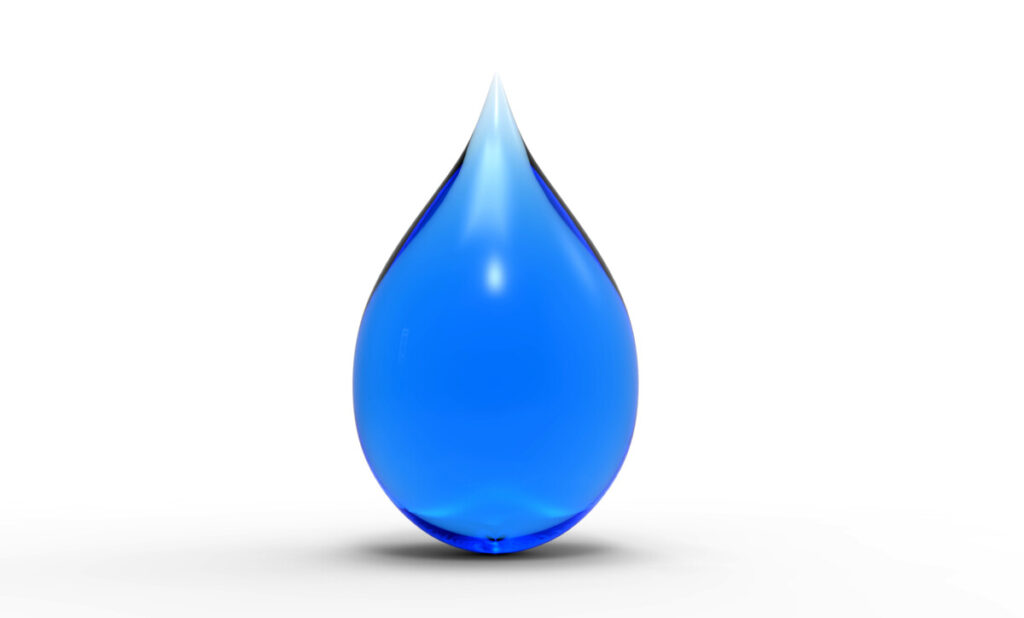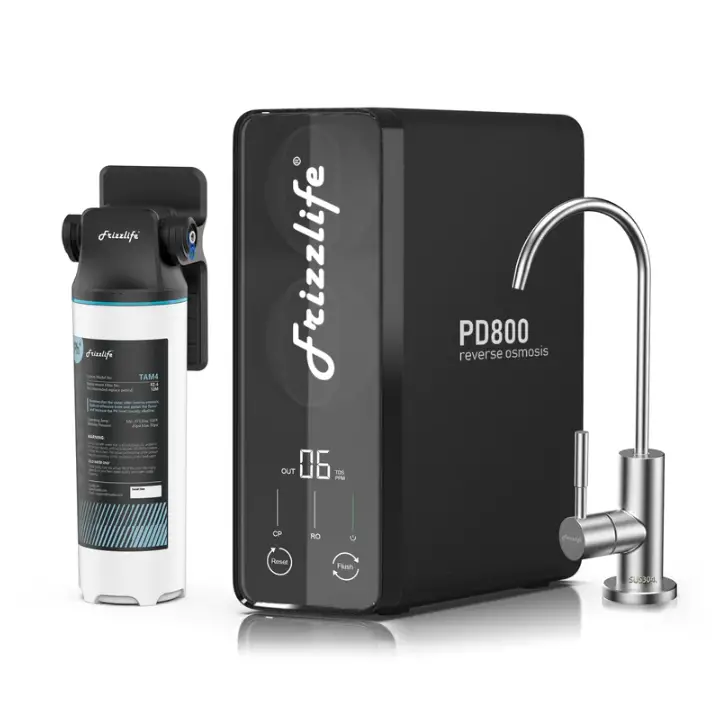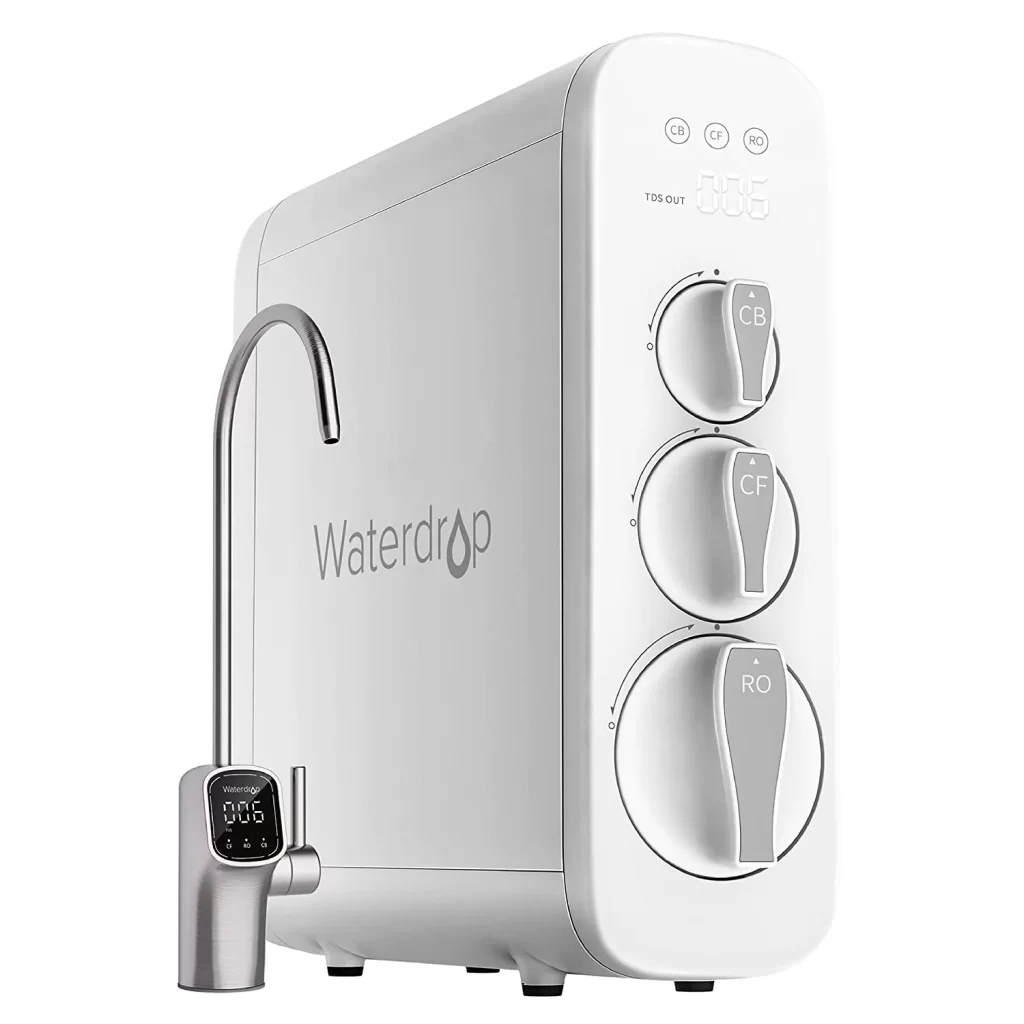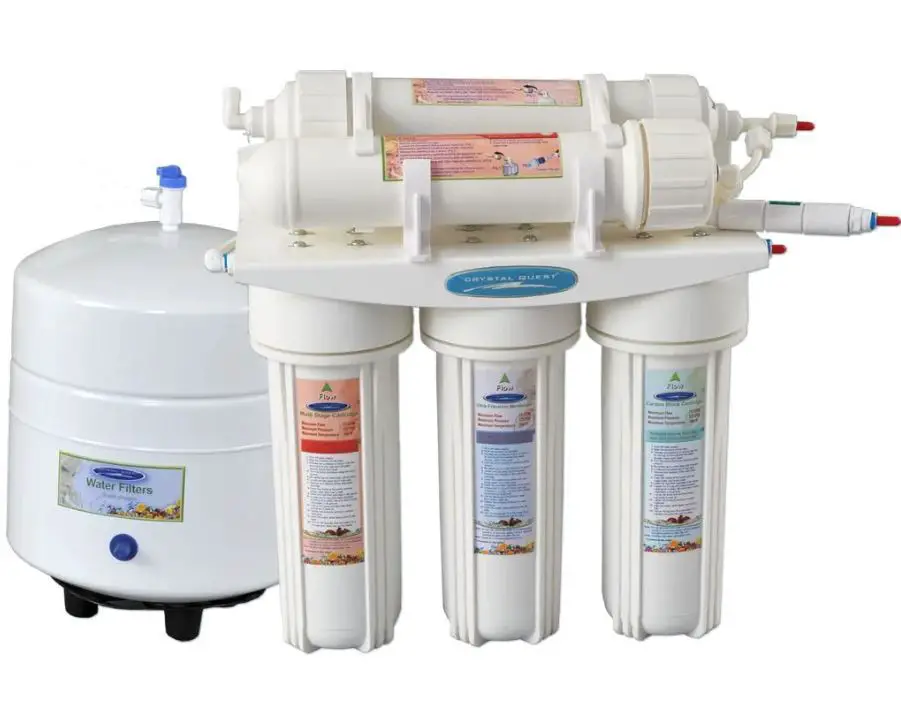There are some reverse osmosis systems that can remove more than 99% phthalates and 98% BPA from water. However, only systems with membranes made from polyamide are able to remove high amounts of BPA. Membranes made from cellulose cannot remove more than 40% of the BPA in water.
BPA (Bisphenol A) and phthalates are both chemicals used in the production of plastics. BPA is used in the production of some hard plastic items. Phthalates, on the other hand, are used in making soft, flexible plastics such as food packaging and baby pacifiers.
Both BPA and phthalates are potentially harmful chemicals when taken into the body. In this article, we cover how they enter our water supply, and look at different reverse osmosis systems that can help you remove BPA and phthalates from your water.
BPA and Phthalates in our water
BPA is an industrial chemical primarily used to harden plastics.
It is a colorless chemical that is present in food containers, medical devices, baby feeding bottles, and hundreds of other products we use every day.
Phthalates are chemicals closely related to BPA, but have different uses. Phthalates are added to plastics to make them more flexible and durable.
They can be found in water bottles, children’s, shower curtains, and many other everyday items.
BPA and phthalates can leach into water if the water is in a bottle or jug that contains BPA or phthalates.
The chances of this happening increase when the water is heated. The concentration or amount of BPA and phthalates will also increase with heat. Water bottles left in cars during summer are a prime example of how these chemicals can easily enter your water without you realising it.
BPA and phthalates can also enter your water supply from landfills.
Water leaches out of landfills and contains high levels of BPA and phthalates from industrial waste. This water can mix in with natural water sources such as lakes and underground aquifers.
It is not very easy to detect the presence of these chemicals in water, especially phthalates which can’t be seen, tasted, or smelled in water. This is unlike BPA which can’t be seen but has a mild odor and taste.
Despite being difficult to detect, water that contains BPA and phthalates is potentially dangerous to your health.
Health Effects of BPA and phthalates
BPA and phthalates are endocrine-disrupting chemicals (EDCs).
EDCs disrupt the normal functioning of the hormones in our body including their production, release, transport, action, metabolism, and excretion by the body.
When hormones such as estrogen, thyroid hormone, testosterone, and insulin are affected, it can put you at risk of developing health issues such as Type II Diabetes Mellitus, growth retardation, and allergies.
How Some Reverse Osmosis Systems Remove BPA & Phthalates
Reverse Osmosis removes contaminants from water, including BPA and Phthalates, but not all systems are effective.
RO systems push water under high pressure through a semi-permeable membrane that filters out unwanted contaminants, producing clean water.
The semi-permeable membrane (a type of filter) has tiny, microscopic pores that allow only small water molecules to pass through.
Membranes that are made from polyamide can remove more than 98% BPA, but those made from cellulose cannot remove more than 40% – that’s less than half the amount!
While all standard RO systems can remove >99% of phthalates.
So, a good reverse osmosis system can remove BPA and phthalates almost completely.
If your water supply is contaminated by BPA and/or phthalates, or you’re worried that it is, you can solve this problem by installing an under-sink reverse osmosis system. This will purify the water coming out of your faucet.
You can also install a whole house reverse osmosis system if you want to purify the water coming out of every tap.
An added advantage of using reverse osmosis to purify your water is that several other contaminants that may be in your water unknown to you, are also removed by this technology.
While reverse osmosis is one of the best options for removing BPA and phthalates from water, this method does have disadvantages. For one, reverse osmosis can cost a lot of money to install, maintain, and use.
On its own, a whole-house RO system may cost up to $3,000, not including installation costs. However, there are now tankless RO systems that have almost no installation involved, and can easily be done yourself.
There are other variations of reverse osmosis systems. While many have tanks and some are tankless, there are also those with in-built UV lamps.
Reverse osmosis systems that have tanks store water after it has been processed. These tanks are necessary because the filtration process is often slower than the flow rate of tap water.
With already filtered water stored, you can use water faster without waiting for it to go through the process.
Once the water in the tank has gone below a particular level, it automatically starts to filter more water until the tank is full again.
Tankless reverse osmosis systems don’t have storage tanks. Because of advances in technology, these systems filter water on demand. They are fast and more space efficient too.
RO systems with ultraviolet (UV) technology improve your water by providing powerful sterilization, getting rid of microbes like bacteria, algae, cysts, etc. The UV component is usually an add-on for other more standard systems, rather than a stand-alone system.
Best Reverse Osmosis Systems that Remove BPA and Phthalates
Several RO systems on the market do a great job of removing BPA and phthalates from your drinking water. Here are our top picks:
1. Frizzlife Tankless Reverse Osmosis System
There are a range of tankless reverse osmosis systems available from Frizzlife. Frizzlife reverse osmosis systems can remove BPA and phthalates from your drinking water. The removal rate of these substances is 94%-96%.
If either BPA compounds or phthalates are present in your water, or you suspect they are, Frizzlife under-sink reverse osmosis systems can help you.
2. Waterdrop Tankless Reverse Osmosis Systems
Waterdrop also has several reverse osmosis systems which have different features to suit your preference. Waterdrop currently doesn’t have certified test results available for phthalate removal. However, they are a great choice if you’re concerned about the presence of BPA in your water.
3. Crystal Quest Reverse Osmosis Systems
Crystal Quest reverse osmosis systems work very efficiently, passing water through several stages of filtration. Some Crystal Quest reverse osmosis systems have up to 17 stages of filtration, we recommend their 1000M Reverse Osmosis system to remove BPA phthalates.
Crystal Quest reverse osmosis systems remove other common water contaminants, including heavy metals and PFAS. However, most of the reverse osmosis systems offered by Crystal Quest are not tankless. The presence of a tank means it may occupy a lot of space under your kitchen sink.
If you are interested in other ways to remove phthalates from water, Water Purification has detailed information on pitchers, bottles, under-sink filters and distillation available here.
How Do I Test For BPA In Water?
The most reliable method for testing for BPA in water is a laboratory test. Simply, take a sample of your water and send it in for analysis by a certified laboratory.
If you’re concerned about BPA leaching into your water from your plumbing or other sources, you should have your water tested. Laboratories use sophisticated and highly-sensitive detection methods such as gas chromatography and high-performance liquid chromatography.
We recommend the BPA Compounds Water Test from Tap Score.

My tap score is one highly efficient lab testing services that offer specialized BPA compound water tests for targeted analysis of bisphenol A (BPA) and bisphenol F (BPF) in drinking water.
This test can also detect the presence of Bis(2-hydroxyphenyl)methane, Bisphenol A diglycideryl ether, Bisphenol A diglycidyl ether, Bisphenol F diglycideryl ether, and Bisphenol F diglycidyl ether in water.
- When you order this test, you will receive a package containing all the necessary materials you need to properly collect and submit a tap water sample.
- Send back your samples for swift, independent, and certified testing.
- Within two weeks, you’ll receive a comprehensive report on the BPA status of your water.
For more information and to order your BPA compound water testing kit click here.
Are Phthalates Found In Bottled Water?
Some bottles used to bottle drinking water are made of plastic containing phthalates. These phthalates make the plastic more flexible and durable, but can leach out of the bottles and into the water.
This leaching is more likely to occur if the bottle of water is kept under direct sunlight or exposed to heat from other sources.
Scientific studies and tests seem to agree that the number of phthalates generally found in bottled water is low and unlikely to cause adverse health effects, including cancer.
However, while bottled water may not be a major source of phthalate intake for the average individual, it may contribute to the total intake of this chemical and consequently, the negative health effects.



